What if Jerry Sandusky had been a priest?
By John Gilbert
The aftermath of the Penn State scandal surrounding assistant football coach Jerry Sandusky’s sexual molestation of at least 10 young boys over a 15-year period, continues. Sandusky is in prison, for life, we assume. Penn State’s president, vice president, and athletic director are dismissed in disgrace for agreeing to suppress the reporting of Sandusky’s hideous trail of the worst criminal conduct. And coach Joe Paterno was fired, and died, but continues to be disgraced because he promoted covering up the scandal for the sake of the Nittany Lions reputation.
It is absolute overkill how vindictive the American public and sports media have been in trying to heap disgrace and punishment on Penn State’s football program. We can all agree that the law says anyone who knows anything, or suspects anything, about child molestation must report it to authorities or is guilty of violating the law as well, and at Penn State, they blew it.
With that in mind, let’s reread a story on the front page of the Minneapolis Star Tribune recently. It was well-written by Abby Simons, and told the story of Jim Keenan, 45, who claimed he had repressed memories about being sexually abused and molested by a former Catholic priest, Thomas Adamson, in 1980 or 1981, when Adamson was serving at Church of the Risen Savior in Burnsville, MN. Adamson was defrocked in 1984.
Keenan filed a lawsuit six years ago against the Archdiocese of St. Paul and Minneapolis, and the Diocese of Winona, claiming church officials there knew of the sexual abuses and covered it up. The church’s defense was that the six-year statute of limitations had run out, and Ramsey District Judge Gregg Johnson agreed, dismissing the case in 2010 with the ruling that the repressed-memory stance was unreliable. A Minnesota Court of Appeals, however, ruled in favor of Keenan and his attorney, Jeff Anderson, and reversed that ruling a year ago, leading the case on to the Minnesota Supreme Court. The Supreme Court ruled 4-2 that there was no concrete evidence the repressed memory condition was reliable, and overturned the Court of Appeals decision in July of 2012.
In the course of the litigation, the Star Tribune article says, Anderson obtained an archdiocesan list it had compiled showing 33 priests who had been accused of sexual abuse involving minors, and the Diocese of Winona has a similar list of 13 more such abusers. That’s not separate cases, but 46 total priests who have been accused of sexually molesting children.
The Ramsey district judge ruled those lists should be sealed, pending the outcome of the Minnesota Supreme Court’s decision on the case. However, when the Minnesota Supreme Court threw out the lawsuit by a 4-2 vote, with the majority saying repressed memory is not scientifically established, the verdict also left permanently sealed the list of those 33 priests in the Twin Cities and 13 more in the Winona Diocese.
How can that be? If it is a law that anyone knowing or suspecting child sexual abuse must report it, how can the Catholic Church and its regional hierarchy justify putting together a list of priests accused of sexual abuse of youngsters, and not have to report it to authorities or make it public? How can they be innocent while knowingly suppressing this information?
Where are the protests demanding dismissals, trials, and prison sentences for the succession of priests, bishops, cardinals, on up to the Pope, who presumably knew of the abuse charges of some or all of the 46 abusers? Where are all those righteous, anti-Penn State columnists and editorialists who rightfully ripped Jerry Sandusky for using his power as a football assistant coach to abuse kids, and why aren’t they reacting similarly to the dozens of cases of child sexual abuse by priests right here in Minnesota? Is it reprehensible for an assistant college football coach to be a pedophile, but it’s apparently tolerated and allowed to be covered up when similar acts are done by priests?
In Rochester, Minnesota, former priest Thomas Adamson, age 79, is living his life in his own manner, because despite being named in multiple lawsuits, he has never faced criminal charges. Maybe he feels lucky to have gotten away from all but his own conscience. We can only wonder what he was thinking about as he watched, listened to, and read the avalanche of venom aimed at Jerry Sandusky during his trial, and Penn State in the aftermath. Maybe he sympathizes with Jerry Sandusky. And maybe he realizes that Sandusky would have been much better off if, instead of being an assistant football coach, he had been a priest.
Twins entertain, regardless of record
By John Gilbert
As we head into the All-Star break, one thing has become remarkably evident. It doesn’t matter whether the Minnesota Twins scratch and claw their way to .500, or even into contention in the second half, rarely have they been as interesting to watch as this season.
Joe Mauer is the only Twins player headed for the All-Star game, and justifiably after he hit something like .495 for the month of June. And — you read it here first — he will come back and win his fourth AL batting title. Whether he does or not, the Twins have been captivating for baseball fans willing to overlook the frustration of the first six weeks and enjoy the sheer entertainment value the team is offering.
We have catcher-first baseman-designated hitter Mauer as an emblem of the whole Twins season. Off to his worst first month as a Major Leaguer, Mauer has been amazing as he’s climbed to third in the American League batting race. Justin Morneau, his M&M twin until both were plagued with injuries last season, is starting to hit too, and I anticipate a really strong second half for him.
When both of them were slow starting, the Twins were too, as their plunge to the bottom of the standings rotated among failures to hit, score, play defense, and pitch, and usually a combination of at least two of the above.
Talk radio bozos in the Twin Cities — the same ones who have been on Joe Mauer’s case the last two years — were actually suggesting the Twins would have to dismiss manager Ron Gardenhire when things were going bad. Poor Gardy was the victim, rather than the problem, in the first six weeks. It’s tough to come out of Spring Training fired up for a strong season and have everything sputter for over a month.
On the other hand, the current rise of the Twins to respectability has ridden some odd inspirational forces. First off, Scott Diamond was banished to the minors early in training camp, but since being called up in desperation a month ago, Diamond has been the Twins best pitcher. True, Francisco Liriano has come up with a few gems in recent starts too, but he is just living up to expectations when he does that. Finally.
The major sources of inspiration have been twin home run hitters. No, not Mauer and Morneau, but Josh Willingham and Trevor Plouffe. Reports were that Plouffe had “some pop” in his bat, and would be playing for the Twins as soon as he could get a chance and adjust to Major League pitching.
Willingham, signed as a free agent after the Twins let Michael Cuddyer and Jason Kubel both go via free agency, was one of the scariest outfielders I’ve ever seen in a Twins uniform. There have been some real dandies in that category, but early in the season, I watched Willingham misplay pop flies, and once he raced toward left-center for a soft, Texas League single, and he flat over-ran the ball, which went behind him for a double or triple. That was back when we were wondering where the Twins might hide Willingham, since the DH spot was usually filled by Mauer or Morneau.
We also wondered where Plouffe might fit in. Now, as we reach midseason, Willingham has worked hard to improve his defensive play and has now reached the level of at least adequacy. He’ll never be the defensive stalwart Denard Span is in center, or the mercurial Ben Revere is in right, but he’s no longer a liability in left. Especially because he is pounding the ball.
Plouffe, meanwhile, is making strong plays at third base, and the pop in his bat is sending pitch after pitch into the seats, home or road. In Tuesday night’s game at Detroit, the Twins led 1-0, then fell behind 4-1. With two out in the fifth, Revere singled, and his speed prompted a balk, and may have provoked a wild pitch. Mauer socked one up the middle that was very tough to handle behind second base, and he was safe on an error as Revere scored. Next up was Willingham, and he launched one into the left field seats.
The two-run homer tied the game 4-4. It also was Willingham’s 18th homer of the season, tying him with Plouffe for the team lead. After Morneau went out, however, Plouffe came up and whacked another pitch into the left-field seats to give the Twins the lead, reclaiming the team HR lead at 19. It was the sixth time this season that both Willingham and Plouffe had homered in the same game. The game later was tied 6-6 in the seventh when Mauer and Willingham both socked opposite-field doubles, and a sac-fly later, the Twins regained the lead in the crazy game at 7-6.
In the last of the seventh, the Twins got into a bind of sorts, but when slugger Miguel Cabrera blasted a line drive down the third base line, Plouffe lunged to stab the shot with his glove, then fired a bullet across to first for a double play. Just for insurance, Mauer came up again to lead off the ninth, got to a 3-1 count, and drilled a home run to left for an 8-6 cushion. In came Glen Perkins, a fireballing left-hander who has adapted well to the role of closer with Matt Capps out with an injury. Perkins blew down the Tigers to complete a four-game sweep for the Twins.
Go back to the start of the season, when most observers were picking the Tigers, with Prince Fielder added to Cabrera in a potent lineup, to win the pennant, and they were just as certain the Twins would be at the bottom. The Twins are still at the bottom, but you couldn’t prove it by the Tigers, who were sent into another tailspin by the Twins.
It almost seems as though the early-season struggles forced the Twins to play some questionable players in the infield and outfield, but by sheer repetition, or latent skill, those players have become fixtures. At the same time, the pitching staff is improving, with the starters getting better and better, and the middle relief always solid, while Perkins has been nothing short of sensational as the middle-reliever turned closer.
The Twins are poised to play a tough second half. Will it be good enough to get into contention? Probably not. But who cares? The Twins are providing entertainment, night after night, and nothing is predictable or impossible.
East Ridge 13-year-old steals 7A track show
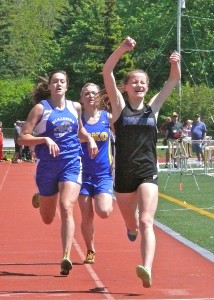
Gracelynn Otis, 13-year-old 8th grader from East Ridge, completed a Section 7A double in the girls 2-mile after also winning the mile -- both with personal bests.
By John Gilbert
Personal bests, meet record times and getting to the state track meet are always the focal points of a sectional track meet. But every once in a while, one specific event goes way beyond such normal highlights and puts an indelible stamp on the entire event. That was the story of the Section 7A track meet, held at Malosky Stadium.
Near the end of the daylong finals, the most scintillating finish came in the girls 3,200-meter run. That’s two miles — eight times around the 400-meter track — which is a long race. This one looked like a good race, with two girls running away with the lead. My attention was focused on a little girl, running back in the middle of the pack most of the way, and when she moved up to third place, I thought it was a worthy performance for someone who looked like the little sister of the other competitors,
With one lap remaining, she was almost the whole length of the straightaway behind the co-leaders, and as the leaders went down the backstretch, I maneuvered to get into position for what I anticipated would be a bang-bang finish.
Imagine my surprise when I focused in on the leaders coming around the final far turn onto the homestretch, and the littlest runner was in the lead! Gracelynn Otis had not only made up 40 yards to catch the leaders, she passed them both coming around the turn, and sped down the final straightaway to hit the finish line with her arms thrust to the skies.
“This is my second 7A meet,” she said. “I was fifth in the two-mile last year. But I’m just an eighth-grader.”
An eighth-grader? How old does that make you?
“Thirteen,” she said.
A couple of observers near me had discussed in expert terms how Gracelynn played it perfectly, holding back and then timing her finish to overtake the leaders. She would have gotten quite a laugh out of such lofty strategy. Actually, she surprised herself, coming into the event with the fourth-best time, and, she admitted, no intention of contending for the victory.
“I felt dead with a lap to go,” she said. “I felt tired because I had just done my personal best in the mile. But then I saw that I had a chance, so I went harder than I had been counting on.”
Her swift finish beat Lindsey Dahl-Holm of Carlton by a half-second, and her winning time of 11:51.50 was the best she had ever done at 3,200 meters — 10 seconds faster than her previous best all season.
That’s what made it such a magical day. Earlier, Gracelynn was ranked third-best going into the 1,600, but she won that with a time of 5:17.22, almost 5 seconds under her previous best time, to beat Esko’s Kailee Kiminski by over 9 seconds. Then in the 2-mile, she not only runs her personal best, but won with a comeback of Kentucky Derby proportions.
Remember the name, Gracelynn Otis from East Ridge. She will be back, and with a better resume, in the spring of 2013, when she is a veteran ninth-grader. Or, in the 7A meet of 2016, when she’ll be a senior who could be heading for her fifth state meet.
I had to ask where East Ridge was. I mean, it’s not like you can head for downtown East Ridge. Years ago, the tiny towns of Alborn and Brookston merged into a consolidated high school and they called it AlBrook — capital “B” please — to keep both identities. Now the kids from Cotton have joined up, and the new school halfway between Duluth the the Iron Range is named East Ridge.
BASEBALL NEARS STATE
Denfeld wound up 18-5 for the softball season, with three of those losses to 7AA champion Forest Lake. Denfeld beat St. Francis behind Nikki Logergren’s pitching, while Forest Lake whipped Duluth East in the regional. Forest Lake, which beat Denfeld 1-0 late in the season, was loaded up and ready for the rematch, scoring eight runs in the first inning, and beating the Hunters 8-1 in the double-elimination tournament. That put St. Francis into the elimination game against East, and St. Francis ended the Greyhounds season, 4-0. Sarah Hendrickson pitched Denfeld to a 2-0 shutout over St. Francis to regain the final pairing, but the Hunters still couldn’t solve Forest Lake’s powerful lineup.
Logergren pitched the first game, then turned the pitching over to Hendrickson, who pitched three straight games. Logergren was busy putting on a batting clinic. It seemed as though every pitch was either a ball or a line drive when Logergren was batting. She hit every ball hard through the first two games, and when she finally hit a short squib against St. Francis, she clearly beat the throw but was called out. Had instant replay been used to review that one, Logergren would have been 8-for-8 by my count.
There was one questionable one, when she hit a low rocket through Forest Lake’s star second baseman, but if she could have seen it, she might have caught it, and it’s a hit in my book. Logergren also got two more hits in the final loss to Forest Lake, which means she went into the sectional tournament hitting something over .500, and then went 9-for-11 in the 7AA tournament. At St. Scholastica next season, Logergren will concentrate on hockey, then on applying her bat to the Saints softball program.
STEWART SECTION
Is it possible for AMSOIL Arena officials to declare that corner area of the stands “Stewart Section?” Dick Stewart, the wonderful man who built Stewart Sporting Goods to the area’s mosts prominent sports store, had become a fixture at all UMD home games since retiring and selling his store. Both at the DECC and now at AMSOIL, Dick would respond to the urging of fans by standing up and waving his little hanging flag thing, to the roars of approval from all the fans.
It seems like just a couple weeks ago when we got a chance to give Dick a big 90th birthday party at Heritage Center, but it was two years ago. Time goes by. Dick’s wife Maxine, who didn’t go to games with Dick in recent years, died on May 26. Nine days later, Dick joined her, dying at age 92 after a fabulous life of brightening the lives of all those he ever knew.
He used to be actively involved with sports teams in the area, but in later years, it was always fun to stop by the store, on 15th Avenue East and Superior Street, and joke around with Dick and the rest of his staff. The best Peewee hockey team in the area was invariably sponsored by Stewart’s. He sold the store, which expanded to be adjacent to Heritage Center, then closed the original store. But it’s still Stewart’s, and the popularity of the man and his store were nothing compared to the adulation heaped on him by UMD fans, particularly throughout the 2010-11 season, when the Bulldogs gave Dick their first NCAA championship.
At his 90th birthday, an endless stream of people came by to wish him well. I said to Dick, “You know, you’re so popular with everybody, maybe you should open a store.” Dick got a big laugh out of that, and it felt good to see him laugh. That’s the way I’ll remember him.
Kara and Abdi — Americans win at Grandma’s
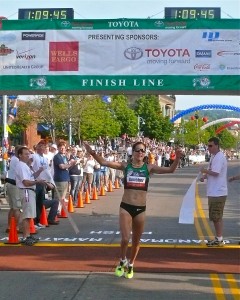
Kara Goucher stopped over on her way to the London Olympics to set the fastest time ever in the women's segment of the Garry Bjorklund Half-Marathon.
By John Gilbert
All 36 Grandma’s Marathons have been unique, even though the 26.2-mile run down Hwy. 61 from Two Harbors to Duluth’s Canal Park has taken on an air of similarity in recent years, to the point where cynics say “Which Kenyan will win this year?” Usually a couple of Ethiopian runners challenge the dominant Kenyans, but without question, the East Africans have taken over the race.
This year, of course, we had the gratifying experience of having Kara Goucher, the hometown Olympic hero, make her first running return since she ran for Duluth East High School. The training regimen for those elite runners who will compete in the Summer Olympics in England in a few weeks calls for specialization of distances as they work up to the Olympic marathon. Timing called for Goucher to run a half-marathon right about now, so Grandma’s, with its accompanying Garry Bjorklund Half-Marathon, was the perfect setting.
On top of that, Grandma’s was designated as the USA Half-Marathon Championship this year, which was even more incentive for Goucher, who came through to win in 1 hour, 9 minutes, 46 seconds — the fastest any woman had ever run Grandma’s half-marathon course. The previous record was a 1:10:00, by Colleen De Reuck of Boulder, Colo., in 2003, also during a USA Women’s Half-Marathon championship.
Goucher’s 1:09:46 was the second-best of all-time to Shalene Flanagan in a USA Women’s Championship, five seconds behind the record set by Flanagan at 1:09:41 in the 2009 USA event in Houston. It was Flanagan who beat Desiree Davila and Goucher in the Olympic Marathon trials, when all three qualified for the U.S. team. Flanagan is Goucher’s training partner in Portland, Ore., where Goucher lives with her husband, Adam, and son, Colt, 2.
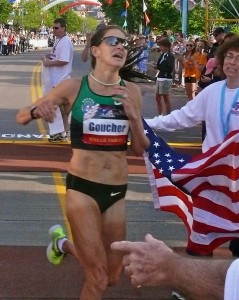
Kara Goucher pulled away to win the half-marathon, then was directed to some television interviews by race director Scott Keenan.
When Goucher finished, she had the perfect line: “I’m going to Bridgeman’s,” she said, referring to Duluth’s ice cream restaurant, which was a regional chain that she loved growing up. Never mind Disneyworld; she wanted a chocolate milkshake.
A day before the marathon, Goucher said, “I’d love to wave to my parents, and grandparents, and all my friends along the route, but I’m not going to. I’m going to wear sunglasses and focus in. I’m here for a reason. I’m super-nervous because there’s a lot of pressure to not mess up.”
Messing up was never in the picture. She admits she had let herself get out of elite running shape last summer. She switched coaches, from former Olympic star Alberto Salazar to Jerry Schumacher, and she has worked long and hard to get herself back up to her standard of competitive readiness. She knows her best days are ahead.
“I’m nowhere near the peak of my career,” Goucher said. 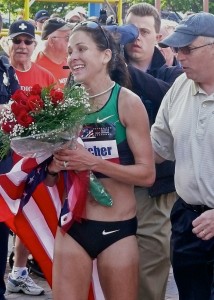 “I feel like London might well be my best, and maybe the first of what will be my four or five best marathons.”
“I feel like London might well be my best, and maybe the first of what will be my four or five best marathons.”
The next day, she ran brilliantly, outdistancing Maegan Krifchin, 24, of Dewitt, N.Y. Krifchin was a compelling story herself; she ran her personal best of 1:10:44 in only her second try at the half-marathon distance. “This was a great experience for me,” said Dewitt. “I was third at Jacksonville in my only other half-marathon [at 1:11:04], and this has been my focus ever since.”
Goucher said she had to concentrate to avoid being overwhelmed emotionally during the race. “This was very personal for me,” she said. “I couldn’t have asked for anything more. It was amazing to see all these people along the way, cheering me on. I had to shut down my emotions. With two miles to go, I literally had goosebumps. I wish I could go back and talk to everybody that I saw along the way.”
In a way, the 2012 Grandma’s was the high school reunion she had missed because of a running conflict. “As a kid, I handed out water to runners in Grandma’s, and I’d run at Park Point,” Goucher recalled.
“When I was young, I worked right over there, at Grandma’s Marketplace,” she said, gesturing across the parking lot from the finish line. “I used to go rollerblading on the boardwalk with my friends, but I thought the people who ran the marathon were crazy. When I was in high school, the half-marathon started, and I thought those people were crazy, too. When I ran track, I never thought of myself as anything more than a miler, or maybe a two-miler.”
And now, after running the 5000 and 10,000 meter runs in the 2008 Olympics, Kara Goucher is not only running marathons but is rising to a personal peak that might crest while going for marathon gold in the Summer Olympics in London. Duluth may well see her again.
Is there a chance she might return to run Grandma’s next summer? “Absolutely,” she said. “If I win the Olympics, I’ll be back here. This would fit perfectly if I run the marathon in the World Championships next year.”
THE FULL MARATHON
Young American runners who got started when their parents drove them to a park so they could run around the track might have trouble accepting, or even understanding, the way of life in East Africa, which spawns so many blade-thin runners that can dominate all the elite spots in U.S. marathons. Normally, the runners from Kenya run away from everybody else. Not this time.
Berhanu Girma defeated Ethiopian countryman Chala Lemi to win this year’s Grandma’s Marathon — the first time an Ethiopian ever won at Grandma’s. Everlyne Lagat of Kenya won the women’s division. Girma’s winning time of 2:12:25 wasn’t among the top 10 all-time Grandma’s records, but it was 33 seconds ahead of Lemi.
Girmo ran amid a group of seven runners for most of the first half of the 26.2-mile distance before he and 2008 Grandma’s winner Lamech Mokono of Kenya pulled ahead. But on this day, the usually dominant Kenyans were upstaged by the pair of 25-year-olds from Ethiopia, both of whom benefitted from growing up running the mountainous terrain of their homeland as a matter of necessity; a way of life. That was good training when the leaders got to the abrupt rise of Lemon Drop Hill, at 27th Avenue West and London Road, and the biggest hill on the course — named for a former restaurant that was located at the top of the rise, but has long since disappeared.
It was there that Girma made his move to leave Mokono behind. “When we went up the steep hill, I got away from the Kenyan,” said Girma. “After the steep hill, no one challenged me.”
At the same Lemon Drop Hill, Lemi made his move. “Before that hill, I was sixth,” said Lemi. “I passed five other runners at the hill.”
Girma was far enough ahead that he was unaware of Girma’s pursuit, and his 2:12:25 was 33 seconds ahead of Lemi’s 2:12:58, while Mokono took third at 2:13:28.
Both Girma and Lemi list Addis Ababa as their home in Ethiopia, but both grew up in smaller villages in the mountainous regions nearby. Both runners’ childhoods give a glimpse into what makes East African runners so superior.
“This is my first time in Duluth, and the only other marathon I ran in the U.S. was the Twin Cities Marathon last October,” said Girma, who didn’t run formally until he joined a club after moving to Addis Ababa. “I grew up in Arsi, a small village with high elevation, and my mother lived in another village, about three hours away, walking. I would run it in an hour and 10 minutes. I would run on normal roads, but there were shortcuts through the fields.”
Lemi said he was from Entoto, a small, high-altitude village. “I used to run to school when I was growing up,” he said. “It was about a two-hour run. Sometimes I would run eight hours in a day.”
No cars, no rides, not always roads. If young men and women in East Africa need to get somewhere, they walk, and more likely run. Not always, however.
Lagat won the women’s full marathon in her third try at Grandma’s. She was third in the 2010 Grandma’s, second last year, and won it this time, clocked at 2:33:14, while Mulu Seboka, another Ethiopian, was a distant second, at 2:34:54. Lagat was in a lead pack of five runners for the first part of the marathon, but pulled ahead and got away from the field despite stomach cramps and an aching hamstring.
“I didn’t think about the pain preventing me from finishing,” said Lagat, 31, who came from Kenya seven years ago to train in New Mexico. “If you think about something like that, it can cause you to stop. Then, near the end, I knew if I could stand the pain for one more mile, I could win.”
Sebaka grew up in the village of Mulo, in the Ethiopian mountains, but at age 27, she is still a novice runner, with a promising future. “I didn’t run as a kid,” she said, through an interpreter. “I didn’t run until we moved to Addis Ababa. One of my friends said I should go to a club and try running, when I was 19 or 20. My first marathon was three years ago in Addis Ababa, and I was fifth. I’ve run a total of nine or 10 marathons, and this was my third in the U.S., but it was not one of my best. I’ve run 2:25 before.”
TRANSPLANTED OLYMPIAN
At first, I flinched when I saw the name Abdi Abdirahman as a U.S. Olympic marathoner, who was coming to Grandma’s to run the half marathon as conditioning, much like Goucher. I have no quarrel with naturalized citizens moving to the U.S. and becoming citizens, but it seems unfair when they make the U.S. Olympic team, leaving behind U.S.-grown and trained athletes.
But after Abdirahman won the men’s portion of the USA Half-Marathon championship, I learned that he is more than just deserving of a spot on the U.S. team. Abdirahman ran the fourth-fastest Grandma’s half-marathon of 1:02:47, winning narrowly over Brett Gotcher, of Flagstaff, Ariz., who was only three seconds back, at 1:02:50, and Ian Burrell, of Tucson, Ariz., who clocked 1:02:51.
“I wasn’t surprised at how competitive it was,” said Abdirahman, 35, who lives in Tucson, Ariz. “I have respect for the great runners I was running against. Nothing was guaranteed, but at the same time, I felt confident. With a mile to go, I started making my move.”
Gotcher said he was amused that some fans cheered “Go, Adam,” to him, mistaking him for Kara Goucher’s husband because of the similarity of their last names. When it was relayed that Abdirahman said he had made a final surge, Gotcher said, “He was surging the whole race. I tried to stay with him, but in the last 250 meters, I couldn’t do it.”
Here is the reason that Abdirahman completely overturned my feeling about athletes who come to the U.S. and get naturalized to compete for the U.S. in the Olympics. “We came as refugees in 1989,” he said. “I was 7, and I had two brothers and two sisters, and another sister was born here. I was born there, but I’ve never been back to Africa since I left.”
While he looks much like the sterotypical East African runners, with shiny black skin and a razor-thin body, Abdirahman has picked up a few phrases growing up in the U.S. Someone asked if he was satisfied with his time. “I’m satisfied,” he said. “Is there a time adjustment for humidity?”
Someone asked about his training regimen. “I’m in the middle of heavy training right now,” he said. “This is perfect for my training. From now on, I’ll run longer distances. It’s not rocket science — if I feel good, I’ll run; if I don’t, I won’t. This is not like basketball; I don’t have to set a pick.”
A reporter unconcerned with political correctness heard Abdirahman tell me he was from Somalia. “You’re Somalian?” the reporter said. “You look Ethiopian.”
Abdirahman didn’t flinch, but he shot a glance at me , and with a subtle grin, said: “Ethiopian? They all look the same to me.”
Fiat Abarth: ‘right amount of wrong’

Stretched longer and housing power, suspension, interior and exterior upgrades, the Fiat Abarth costs $22,000.
By John Gilbert
Advertising can be coersive, exaggerated, informative, and meaningful, sometimes just annoying, other times fun. Then there are those special cases, where an ad can be so memorable it could only be improved if you could bring it to real life.
Fiat has pulled off one of those special ads, and it started with the Super Bowl and carried through to the introduction of the 2013 Fiat Abarth at the car’s introduction, in Las Vegas in early March. Fiat started to bring its subcompact 500 into the U.S. a year ago, and Jennifer Lopez did a series of memorable commercials driving the 500, but the little car drew some, but not a lot, of interest. Then came the Super Bowl.
The Fiat Abarth is a specially modified and turbocharged version of the new little subcompact 500 coupe, adding a new dimension to the 500 for Fiat, Italy’s expansive and technically savvy company, which now owns Chrysler Group. “The 500 is a fun, unique, agile, and cute car,” said Tim Kuniskis, the head of Fiat North America. “The Abarth is a 500 with just the right amount of wrong…It’s flirting with irrational, for $22,000.”
It’s not at all irrational if you thought the Fiat 500 needed a little extra dose of punch, because the Abarth has enough punch to satisfy discriminating performance-oriented drivers, whether on their daily commute, roaming on your favorite twisty roads, or taking advantage of a track-day at a local road-racing circuit. The question was, how to translate the special qualities of the Fiat Abarth, combining its practical side with its exotic Italian passionate heartbeat.
That made the Super Bowl the perfect launching pad for the Fiat Abarth, and it was a provocative ad that has continued, after turning out better than anyone could have imagined. The car comes in different colors, but because of the ad, you’ll have reason to picture it mainly in black.
As always, the Super Bowl was loaded with clever commercials, and sometimes they’re better than the actual football game. If you were normal — or at least a normal, red-blooded male — you undoubtedly remember the commercial where a normal-looking fellow is walking down a busy sidewalk, New York we’d guess, carrying a cappucino, or latte, or mocha, or some such designer coffee he has just purchased. Suddenly he stops in his tracks and stares, because ahead of him, bending over to adjust her high heels, is a stunningly beautiful, dark-haired woman in a provocatively flowing black dress with red trim. She glances back and catches him staring at her, and he freezes. She straightens up and confronts him, slaps him across the face, grabs him by the necktie and pulls him close to her. She reaches into his mocha-latte-cappucino thing and scoops out a fingerful of whipped cream. She puts it into her mouth, but a small bit of it falls, strategically plopping right where her discreetly plunging neckline is most discreet.

Catrinel Manghia repeated her prize-winning performance on Fiat Abarth TV ads at the Las Vegas media introduction. The car looked good, too.
The totally smitten guy is somewhere between shock and ecstacy, as he leans forward, slowly, eyes closed. We think he might attempt to lick up the fallen whipped cream, but as he leans forward, he opens his eyes to find that the most beautiful woman in the world has vanished. In place of his passionate objective is a new passionate objective — a Fiat Abarth, parked at the curb and wearing color-coordinated black paint with red accents.
When the seductive commercial first ran during the Super Bowl, Fiat’s website went instantly crazy. According to Edmunds.com, a widely accepted automotive news website, the Fiat showed an immediate increase of 3,354 percent in inquiries immediately after the Super Bowl ad aired — the largest increase of any of the many cars advertised during the game. Virtually all the hits were for the Fiat Abarth.
Since the Super Bowl, Fiat’s website has registered 8 million hits for the Abarth on Youtube, said Kuniskis, speaking at the news media introduction for the Fiat Abarth, in Las Vegas in early March. There have been more online requests for the Fiat Abarth since the Super Bowl than there had been, total, for the 500 itself in a full year. Read more


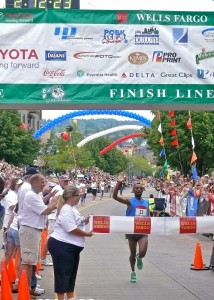
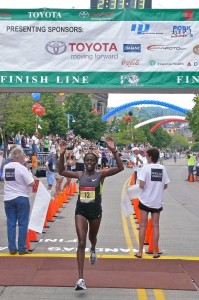


 John Gilbert is a lifetime Minnesotan and career journalist, specializing in cars and sports during and since spending 30 years at the Minneapolis Tribune, now the Star Tribune. More recently, he has continued translating the high-tech world of autos and sharing his passionate insights as a freelance writer/photographer/broadcaster. A member of the prestigious North American Car and Truck of the Year jury since 1993. John can be heard Monday-Friday from 9-11am on 610 KDAL(www.kdal610.com) on the "John Gilbert Show," and writes a column in the Duluth Reader.
John Gilbert is a lifetime Minnesotan and career journalist, specializing in cars and sports during and since spending 30 years at the Minneapolis Tribune, now the Star Tribune. More recently, he has continued translating the high-tech world of autos and sharing his passionate insights as a freelance writer/photographer/broadcaster. A member of the prestigious North American Car and Truck of the Year jury since 1993. John can be heard Monday-Friday from 9-11am on 610 KDAL(www.kdal610.com) on the "John Gilbert Show," and writes a column in the Duluth Reader.